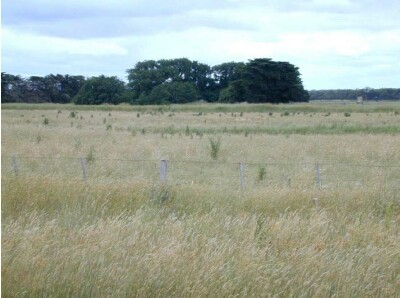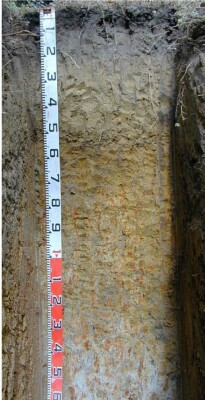GHF04d
Location: Bessiebelle
Australian Soil Classification: Melacic (& Ferric), Calcic, Yellow DERMOSOL (gravelly)
General Landscape Description: Level Plain
Site Description: Flat
Land Unit: Strathdownie
Geology: Quaternary Sediments
General Land Unit Description: This land unit comprises the Quaternary lacustrine geology south of the Glenelg River. The lacustrine deposits include lagoonal, swamp and local colluvial deposits formed in low-lying wetlands and depressions between stranded beach ridges. Parent material in this land unit comprises of sand, silt, sandy clay, peat, marl and freshwater limestone, occurring in relatively unconsolidated forms.
The soils are variable throughout this land unit due to varying depositional environments. A common soil type is a strong texture contrast soil (Chromosol) commonly with a bleached A2 horizon and a mottled subsoil (indicative of impeded internal drainage). The sandy topsoil can be very deep in some soils. Vertosols are also common on the plains and swales in between the dunes. Podosols occur on the flats as well as on the dunes and that may have been mapped as part of this land unit due to restrictions of scale. Many of the soils are poorly drained and exhibit signs of a perched watertable.
This site has a 1.5 year old Eucalyptus globulus plantation on ex-agricultural land. The site is probably a heathland/bog. The trees in this plot have been severely affected by waterlogging.

Soil Profile Morphology
Surface
| A11 | 0-20 cm | Black (10YR2/1) light clay; weak angular blocky structure (50-100 mm); firm consistence when dry; few medium ferruginous nodules; many fine macropores; areal porosity 0.6%; common medium roots; clear and smooth transition to:
|  |
| A12 | 20 – 40 cm | Black (10YR2/1) light clay; unable to assess structure, consistence or macroporosity due to the presence of very many segregations; very many coarse ferruginous nodules; dry; few fine roots; clear and smooth transition to:
| |
| Subsoil | |||
| B21 | 40 – 75 cm | Brownish yellow (10YR6/6), medium clay; moderate subangular blocky structure (50-100 mm) parting to strong subangular blocky structure (10-20 mm); weak consistence when moderately moist; common coarse ferruginous nodules; common very fine macropores; areal porosity 0.05%; no roots observed; gradual and smooth transition to:
| |
| B22 | 75 – 120 cm | Light grey (10YR7/1) with many coarse distinct brownish yellow (10YR6/7) mottles, medium clay; moderate subangular blocky structure (50-100 mm) parting to moderate subangular blocky structure (10-20 mm); weak consistence when moderately moist; common coarse ferruginous nodules; common very fine macropores; areal porosity 0.05%; no roots observed; gradual and smooth transition to:
| |
| B23 | 120 – 150 cm | Grey (5YR6/1) with many coarse prominent yellowish brown (10YR5/8) mottles, medium heavy clay; moderate subangular blocky structure (50-100 mm) parting to moderate subangular blocky structure (10-20 mm); weak consistence when moist; common very fine macropores; areal porosity 0.05%; no roots observed.
| |
| 150 – 170 cm | Similar to layer above.
| ||
| 170 – 350 cm | Grey and yellow clays, many large (60-200 mm) limestone fragments, limestone appears to be solid at about 350 cm, with water on top of the limestone. |
Soil Profile Characteristics:
- | pH | Salinity | ||
Surface Soil (A11 horizon) | Strongly Acid | Low | Non-Sodic | None |
Subsoil (B21 Horizon) | Slightly Alkaline | Low | Non-Sodic | None |
Deeper Subsoil (120-150 cm) | Strongly Alkaline | Low | Non-Sodic | None |
Chemical and Physical Analysis:
Horizon | Horizon Depth (cm) | pH (water) | pH (CaCl2) | EC dS/m | Exchangeable Aluminium ppm | Exchangeable Acididty meq/100g | Exchangeable Cations | Coarse Sand (0.2-2.0 mm) % | Fine Sand (0.02-0.2 mm) % | Silt (0.002-0.02 mm) % | Clay (<0.002 mm) % | Field Capacity % w/w | Wilting Point % w/w | |||
Ca | Mg | K | Na | |||||||||||||
meq/100g | ||||||||||||||||
A11 | 0-20 | 5.1 | 4.6 | 0.13 | 26 | 14 | 6.3 | 2.1 | 0.39 | 0.12 | 19 | 36 | 10 | 28 | 30.6 | 17.3 |
A12 | 20-40 | 6.6 | 6.0 | 0.06 | 5.0 | 4.8 | 2.2 | 0.25 | 0.17 | 49 | 22 | 6 | 23 | 19.3 | 11.2 | |
B21 | 40-75 | 7.8 | 7.3 | 0.12 | 8.6 | 4.6 | 0.13 | 0.41 | 18 | 22 | 32 | 28 | 36.8 | 21.6 | ||
B22 | 75-120 | 8.4 | 8.0 | 0.19 | 14 | 4.1 | 0.12 | 0.51 | 28 | 23 | 7 | 44 | 29.8 | 18.0 | ||
B23 | 120-150 | 8.6 | 8.0 | 0.23 | 26 | 5.8 | 0.29 | 1.0 | ||||||||
Profile Described By: Ian Sargeant and Paul Feikema (December 2000)


